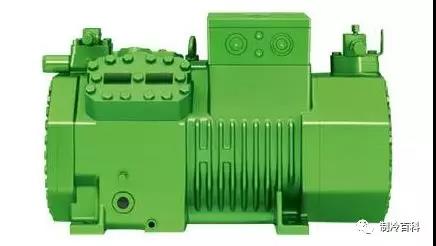News Center
- Fault analysis of compressor liquid strike
- date: 2020-1-10 hits:22648
The phenomenon that liquid refrigerants and / or lubricants in the Refrigeration System Damage the suction valve plate when they are sucked into the cylinder of the compressor, and they are not discharged rapidly after entering the cylinder, the phenomenon of transient high hydraulic pressure produced by the compression of a Piston near TDC is often referred to as a hydraulic blow. Hydraulic blow can cause damage to compressed components such as valves, Pistons, connecting rods, crankshafts, Piston pins, etc. in a short period of time and is a deadly Reciprocating compressor. The occurrence of a liquid strike can be prevented by reducing or preventing the liquid from entering the cylinder, so the liquid strike can be completely avoided.

Usually, fluid percussion can be divided into two parts or processes:
• first, when more liquid refrigerants, lubricants, or a mixture of both enter the compressor cylinder at a higher speed with suction, due to the impact and incompressibility of the liquid, it can cause excessive bending or fracture of the Suction Valve Plate;
secondly, when the liquid in the cylinder which has not been evaporated and discharged in time is compressed by the Piston, the huge pressure appears in an instant and causes the deformation and damage of the stressed parts. These forces include Suction and Exhaust Valve Plate, Valve Plate, valve plate gasket, Piston (top) , Piston Pin, connecting Rod, crankshaft, bearing, and so on.
The process and phenomenon of refrigeration compressor liquid strike
Suction Valve piece broken: The compressor is a compressed gas machine. Typically, the Piston compresses the gas 1,450 times per minute (for a semi-hermetic compressor) or 2,900 times per minute (for a fully hermetic compressor) , that is, it takes 0.02 seconds or less to complete an intake or exhaust process. The size of the suction and exhaust holes on the Valve Plate and the elasticity and strength of the Suction and exhaust valve plates are designed according to the flow of gas. From the point of view of the force on the Valve Plate, the impact force produced by the gas flow is relatively uniform.
A liquid is tens or even hundreds of times as dense as a gas, so it flows with much more momentum than a gas and produces much more impact. The flow in the cylinder with more droplets in the suction is two-phase flow. The impact of two-phase flow on the suction valve plate is not only strong but also high frequency, just like a typhoon with pebbles hitting on the glass window, its destructiveness is self-evident. The fracture of suction valve is one of the typical characteristics and process of fluid percussion.
Refrigeration compressor connecting Rod Fracture: compression stroke time of about 0.02 seconds, and the exhaust process will be shorter. Droplets or liquid in the cylinder must be discharged from the vent in such a short time, and the speed and momentum are great. The situation of the exhaust valve piece is the same as that of the suction valve piece. The difference is that the exhaust valve piece is not easily broken because of the limited position plate and the spring plate support. When the impact is serious, the limit plate will also be warped.
If the liquid does not evaporate and leave the cylinder in time, the Piston compresses the liquid near TDC, which, because of its short duration, appears to be an impact, and a metallic knock is heard in the cylinder head. The compressed liquid is another part or process of the fluid percussion phenomenon.
The high pressure produced in the moment of liquid impact is very destructive. Besides the bending and even breaking of the connecting Rod, other compression force components (Valve Plate, Valve Plate Pad, crankshaft, Piston, Piston Pin, etc.) will also be deformed or damaged, but they are often neglected, or it could be confused with excessive exhaust pressure. It is easy to find bent or broken connecting rods and replace them without checking other parts for deformation or damage, thus laying the foundation for future failures.
The fracture of the connecting Rod caused by the hydraulic blow is distinguishable from that caused by the holding of the axle and the Piston biting the cylinder. First of all, the connecting rod bending or breaking caused by hydraulic impact in a short period of time, the Piston and crankshaft at both ends of the connecting rod move freely, generally there will not be serious wear and tear caused by holding the shaft or biting the cylinder. Although the Broken Suction Valve fragment occasionally causes severe scratches on the Piston and cylinder surfaces, surface scratches are quite different from lubrication failures that cause wear.
Secondly, the break of connecting Rod caused by hydraulic impact is caused by pressure. Connecting Rod and stubble have extrusion characteristics. Although the connecting Rod may break after the Piston Bites the cylinder, the Piston must be stuck in the cylinder. After holding the connecting rod broken is even more different, connecting rod big head and crankshaft have serious wear and tear, causing the breaking force belongs to the Shear Force, stubble is not the same. Finally, before holding the axle and biting the cylinder, the motor will operate over-load, the motor will heat seriously, and the thermal protector will act.
Second, the liquid source obviously, can cause the compressor to hit the liquid is nothing more than the following sources:
Obviously, the liquid that can cause compressor fluid to hit is nothing more than the following sources:
• return liquid, which is liquid refrigerant or lubricant returned to the compressor from the evaporator;
• Foam when starting with liquid;
• too much lubricant in the compressor.
Article collation comes from "Refrigeration Encyclopedia" ,
Cold and warm life binger accompanied-
pre:Flammable and explosive R290 r
next:Influence of evaporation and c - back


